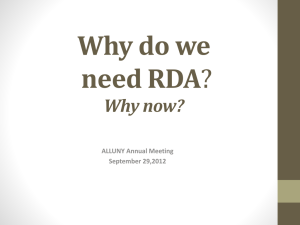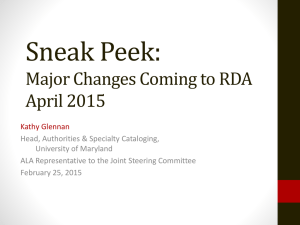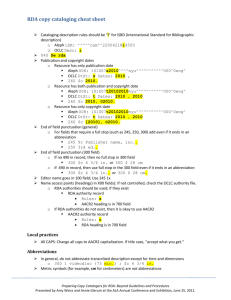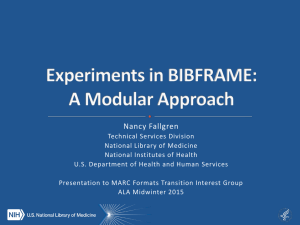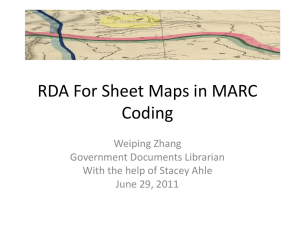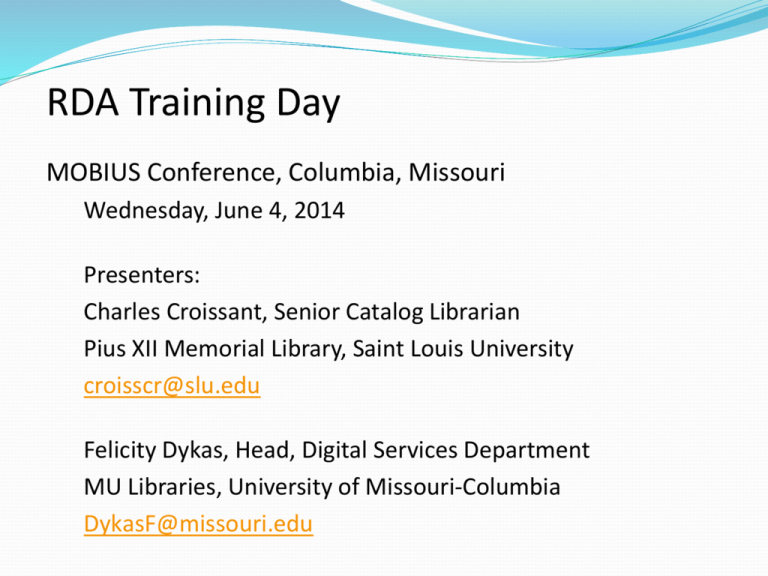
RDA Training Day
MOBIUS Conference, Columbia, Missouri
Wednesday, June 4, 2014
Presenters:
Charles Croissant, Senior Catalog Librarian
Pius XII Memorial Library, Saint Louis University
croisscr@slu.edu
Felicity Dykas, Head, Digital Services Department
MU Libraries, University of Missouri-Columbia
DykasF@missouri.edu
“Why Do We Catalog?”
People with
information
needs
Catalog records
Library
resources
2
It’s all about access!
Providing access via any piece of
information a user might know:
An author’s name
A title
An editor’s name
A subject
Keywords
3
How?
Create bibliographic records
Bibliographic records in catalogs
Catalogs with features and function
Indexing rules
Display rules
Navigation
Metadata
Metadata: “data about data”
Catalog records are metadata
Library resource = Data
Catalog record = Data about the
resource = Metadata
Important:
Consistency
Standardization
Using controlled vocabularies (thesauri)
“Why RDA?”
“Why don’t we just revise AACR2?”
Evolving cataloging environment
RDA an improvement over AACR2
6
The Cataloging Environment -- Internet
Catalogs are no longer in isolation
Global access to data
“linked data systems”
Integrate bibliographic data with
wider Internet environment
Share data beyond institutions
Any user – any place – any time
7
The Cataloging Environment
Databases,
Repositories
Services
VIAF
LCSH
Web front
end
8
RDA has a philosophical foundation:
FRBR
Functional Requirements for
Bibliographic Records
•
•
•
•
International collaboration
Produced by IFLA
Issued in 1997
Pushes us to a higher intellectual rigor
9
What do we really mean when we say “book”?
“Book”
Door prop
(item)
“publication”
at bookstore
any copy
(manifestation)
10
Cited from Patrick LeBoeuf, former chair of the IFLA FRBR Review Group
10
What do we really mean when we say “book”?
“Book”
– Who illustrated this?
(expression)
– Who wrote this?
(work)
11
Cited from Patrick LeBoeuf, former chair of the IFLA FRBR Review Group
11
The FRBR user tasks
Find (a resource that meets certain criteria)
Identify (make sure the resource is the one you want and not
some other, similar resource)
Select (from a number of possible resources, select the one
that is most useful to you in your particular situation)
Obtain (get it from its current location to a place where you
can use it – gaining access to the resource)
(navigate) (being able to make your way through a catalog, a
search engine, a Web site to find what you want)
The FRBR Model
• An “entity-relationship” model
– STEP 1: identify all the possible entities in the process you
are analyzing.
– STEP 2: Identify all the attributes that can be possessed by a
particular entity.
– STEP 3: Identify all the possible relationships that can exist
between any two of your entities.
Step 1 of the process identified 3 groups of entities.
Group 1, the Bibliographic Entities:
the bibliographic “Great Chain of Being”
Work (the most abstract level)
is realized through
Expression
is embodied in
Manifestation
is exemplified by
•
Item (the most concrete level)
WEMI
(“work, expression, manifestation, item”)
Work = a distinct creation
Expression = the intellectual or artistic realization of a work
Manifestation = physical embodiment of an expression of a
work (i.e., the publication of a particular expression in book
form)
Item = a single exemplar of a manifestation (i.e., a single
copy of a book)
• The other groups of entities:
• Group 2: The “agent” entities – individual persons,
corporate bodies.
• Group 3: The “subject” entities – concepts, events,
places, etc., plus any of the Group 1 and Group 2
entities.
Each entity is described by recording its attributes.
Entities are linked to each other by relationships.
Leo Tolstoy in FRBR
(the “linked data” model)
PERSON
Tolstoy, Leo
1828-1910
Russian
novelist
WORK
Anna Karenina
Novel
WORK
Voĭna i mir
Novel
EXPRESSION
War and peace
(English translation)
Is embodied in
MANIFESTATION
1904 English edition
of War and peace
Publishes
CORPORATE BODY
William Heinemann Ltd.
English publishing house
PERSON
Constance Garnett
1861-1946
Role: literary translator
ITEM
Copy of Heinemann’s 1904 edition
held by Harvard Library
RDA – an overview
What RDA is: a set of instructions on how to
record bibliographic data
What RDA is not: a display standard
(RDA says nothing about how a record should be
displayed on your screen; it says nothing about
what data format to use)
RDA’s “world view”
Bibliographic resources = carriers of content
Content → intellectual
Carrier → physical
Content
maps to
Work and Expression level
Carrier maps to
Manifestation and Item level
Moving from MARC to RDA
MARC record structure is “flat”
RDA envisions Linked Data
Systems
Author
Uniform Title
Title
Tolstoy, Leo, graf, 1828-1910.
Voĭna i mir. English
War and peace / Leo Tolstoy ; translated from the
Russian by Richard Pevear and Larissa
Volokhonsky.
Edition
1st ed.
Published
New York : Alfred A. Knopf, 2007.
Description
xviii, 1273 p. ; 25 cm.
Bibliography
Includes bibliographical references (p. [1223]-1247)
and index.
Subjects
Russia -- History -- Alexander I, 1801-1825 -- Fiction.
Napoleonic Wars, 1800-1815 -- Campaigns -- Russia -Fiction.
Related Author Pevear, Richard, 1943Volokhonsky, Larissa.
ISBN
9780307266934
A new emphasis in RDA
Relationship
designators
Identifiers
24
Relationship Designators
(remember relator terms and codes?)
author
editor
translator
compiler
conductor
composer
performer
25
Relationship Designators
in MARC: subfield $e
100
100
700
700
1_
1_
1_
1_
Brown, Dan, $e author.
Smith, Edward, $d 1954- $e compiler.
Lee, Sandra, $d 1971- $e editor.
Bernstein, Leornard, $d 1918-1990, $e conductor.
in a Linked Data System:
the Designator is a data element of its own
could be expressed as a URL
26
Identifiers
definition: a character string
uniquely associated with an entity
(e.g. work, expression, person,
corporate body, etc.)
27
RDA – Pathway to the
Semantic Web
in a Linked Data System:
relationship designators
+
identifiers
=
more data manipulation by machines
28
In bib record for BBC video of Pride and Prejudice:
conventional note:
500 __ Based on the novel by Jane Austen.
(Humans can understand this, machines cannot)
In a linked data system:
Record for
BBC video.
Identifier:
2abc15x
defined link:
Is Adaptation Of
machines are able to interpret this.
Record for the
work, Pride and
prejudice by Jane
Austen.
Identifier:
z345x1bc
RDA is granular -Data elements -- each element contains just one
piece of data, of just one type.
RDA’s structure is based on FRBR (no more Areas of
Description as in AACR2)
(go to RDA toolkit)
Helpful tools:
RDA mappings
Especially MARC Bibliographic to RDA,
but also RDA to MARC Bibliographic
Advanced search (icon: magnifying glass)
AACR2 rule number search
Group exercise 1
THE CASE FR RDA
All Rights Reserved c2012
The College of the Plains
Free Our Data!
BY
ISBN: 978-0-8014-3005-3
Bret Dee
University of Versailles
Tom D. Knot
College of the Plains
Cora Lee Sims
Printed on acid-free paper
Tia Smart
IFLA
Liberating Library Series
PLAINS, MISSOURI
The College of the Plains
(Additional information:
Title on cover: The case for RDA
Pagination: xiv, 345 pages
Illustrations: Screen shots in color, charts, 2 photographs
Size: 23 1/2 x 16 cm
Bibliography at the end of each chapter
Index on pages 340-345)
Login to Connexion Browser
Group exercise 2, Emily Dickinson’s approving God
(small groups)
38
Page facing title page (“series title page”)
19th century American poets
A series edited by
Paul Everett Hanson
University of Missouri, Columbia
Volume 21
ISSN: 1358-0422
39
Title page verso
First published in 1998
Second corrected edition, 2006
prepared by Jane Hutchinson
©1998, ©2006
ISBN: 978-0-8444-1162-0
40
RDA “pure”
RDA and Access Points for Names
Group 2 entities
Persons (RDA Chapter 9)
(Families) (RDA Chapter 10)
Corporate bodies (RDA Chapter 11)
Group 3 entity
Place names (RDA Chapter 16)
43
RDA – Authority records vs.
Identity Records
Recording attributes
“Core” = always record if available
“non-Core” = not required, but a
good idea to record if available
Identifying the “preferred name”
Establishing the authorized access
point
Documenting the decision
44
RDA’s workflow for creating
identity records
First, record all the available
attributes
For persons, see Chapter 9.2 through
9.18 (go to RDA Toolkit)
Then, determine which attributes
are needed for establishing an
“authorized access point” (“AAP”)
AAP = “Preferred name” + additional
attributes as instructed, see Chapter
9.19.
45
“Identity records” and MARC
To accommodate RDA, the MARC
format has added new fields:
370
371
372
373
374
375
377
(associated place)
(address)
(field of activity)
(associated group)
(occupation)
(gender)
(language)
46
47
AACR2 style
48
RDA style
49
For establishing a personal name, the
important chapters are:
9.2. Name of the person
9.19. Constructing access points to
represent persons
And chapters for any attributes we need for
1xx. Dates, fuller form of name, titles, etc.
50
What is the preferred name of the
person?
The preferred name is the name by which
the person is commonly known
(9.2.2.3)
Names can be taken from any source
(9.2.1.2)
BUT: There is an order of preference
(9.2.2.2):
Preferred source of information (in AACR2,
the “chief source of information,” i.e. title
page)
Other formal statements
Reference sources
51
What is the name by which a
person is commonly known?
Possibilities:
Real name
Pseudonym
Title of nobility
Nickname
Initials
Other appellation
52
53
54
NAXOS
55
Other details
56
8.5 General guidelines on recording
names: capitalization, numbers
expressed as numerals or words,
accents, hyphens, spacing of
initials, abbreviations
57
Different forms of the same name
(9.2.2.5) – see special instructions
If it is known that the person prefers a
name that is different from usage (i.e. form
found on title pages), follow that
preference.
Names in specific categories (e.g.,
Burmese): See additional instructions.
Name varies in fullness: choose the form
most commonly found -- if no form
predominates, use the latest form.
Language: Choose the form that is used in
most resources.
58
9.2.2.9.5 – words, etc., indicating
relationship
In Portuguese names, the words
Filho, Junior, Neto, Netto, or
Sobrinho are part of the surname.
Designations like Jr., Sr., II, III,
are recorded as part of the preferred
name (compare AACR2)
They follow the given name and are
preceded by a comma:
Saur, Karl-Otto, Jr.
59
Step 3: Construct the authorized
access point (AAP) (9.19)
Use the preferred name as the basis
of the AAP.
Make additions as instructed in
9.19.1.2-9.19.1.7.
60
If the name does not convey the idea of a
person, add information even if not needed
for differentiation (9.19.1.1)
Term that indicates profession or
occupation: Stone Mountain (Writer)
Term that indicates a fictitious or
legendary character: Wolverine
(Fictitious character)
Term that indicates type, species or breed
for non-human entities: Battleship (Race
horse)
61
Title or other designation associated
with the person (9.19.1.2)
Royalty (always): Charles, ǂc Prince of Wales, ǂd
1948Nobility (always):
Religious rank (if given name is first element and
commonly appears with name): Mary Francis, ǂc
Mother, ǂd 1921Saint (add unless pope, emperor, empress, king,
or queen): Hildegard, ǂc Saint, ǂd 1098-1179
Spirit (always): Presley, Elvis, ǂd 1935-1977 ǂc
(Spirit)
Other (if needed): Moses ǂc (Biblical leader)
62
Date of Birth and/or Death
(9.19.1.3)
Add if known (LC-PCC PS)
Use hyphens (LC-PCC PS)
63
Fuller Form of Name (9.19.1.4)
Add if needed to differentiate
If part of the forename or surname used is
represented by an initial, add if important
for differentiation (LC-PCC PS)
Eliot, T. S. ǂq (Thomas Stearns), ǂd 18881965
[today might not add the fuller form of
name]
Add unused forenames or surnames only if
needed for differentiation (LC-PCC PS)
Richardson, Alan ǂq (Alan John)
64
Period of activity of person and/or profession
or occupation (9.19.1.5)
Add if needed for differentiation
Allen, Charles, ǂd active 18th
century-19th century
Butler, Jean ǂc (Composer)
65
Other term of rank, honour, or
office (9.19.1.6)
Add if needed to differentiate
Must have appeared with name
Wood, John ǂc (Captain)
66
Other designation (9.19.1.7)
Add if needed to differentiate
Nichols, Chris ǂc (Officer of the
North Oxford Association)
67
PN summary (for typical names)
Preferred name
Always add dates when known
Add the following as needed, in this
order of preference
Fuller form of name
Period of activity or Profession or
occupation
Other designation
68
Corporate names (11)
Same sources of information
Same process
69
Conventional names (11.2.2.5.4)
A conventional name is a name,
other than the real or official name,
by which a corporate body has
come to be known. If a body is
frequently identified by a
conventional name in reference
sources in its own language, choose
this conventional name as the
preferred name.
70
Governments. The conventional
name of a government is the name
of the area exercises jurisdiction.
This can be a country, province,
state, county, municipality, etc.
71

